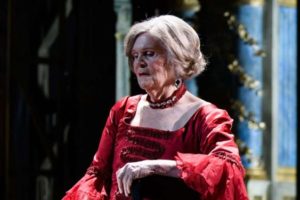
Deutsche Grammophon has just released Anna Netrebko: Live at the Metropolitan Opera, a CD
with 11 excerpts recorded live from her Met performances from 2002 through 2010. Released to feature the soprano just prior to her opening in the Met’s Anna Bolena, the CD features Netrebko singing solo arias as well as duets with such colleagues as Alagna, Hvorostovsky, Florez, Calleja, and Beczala.
One of the very real joys of this program is hearing how Netrebko’s voice has changed and matured. The excerpt from 2002’s War and Peace shows the young soprano with a crystalline lyric sound; it is striking how the voice has become more lush, womanly, and sensual in the ensuing years. She has gained considerable power, richer and juicier tone, and sounds more confident and charismatic than ever before.
The excerpts are, of course, chosen to show Netrebko’s considerable strengths. The weakest selection is the first, “Qui la voce” from 2007’s I puritani. It was wise here to choose a piece of Elvira’s music that is slow and quiet, avoiding any of the treacherous heights and runs that were fudged a bit in the performance. The singing is quite beautiful in this selection, but the character’s mental and emotional state doesn’t come through.
“Ya ne budu—Kak solnca za goroy” from the 2002 War and Peace, a brief scene between Netrebko’s Natasha, Hvorostovsky’s Prince Andrei, and the Sonya of Ekaterina Semenchuk, is an absolute delight. Gergiev leads a sumptuous reading of this music, and Netrebko’s charming, fresh-voiced Natasha is wonderful, with an easy top; she imbues this scene with tremendous energy and vivaciousness.
The same energy and vivaciousness grace the next two selections, a limpid “Vedrai, carino” from Don Giovanni (beautiful but maybe a touch too limpid), and particularly in the delightful scene from Don Pasquale (2006) featuring Kwiecien, Alaimo, and Florez. The singing by all four is joyous and charming, and Netrebko’s bumptious Norina is one of her strongest characterizations. Maurizio Benini keeps the tempos bright and bubbly, bringing out all the comic possibilities in Donizetti’s rich score.
The selection of the Rigoletto excerpt seems baffling. Instead of “Caro nome” or one of the duets with the Duke or Rigoletto, we get “Ah, piu non ragiono!”, the scene right before Gilda’s murder. This excerpt is mostly about the Maddalena and Sparafucile’s music. Eric Halfvarson and Nancy Fabiola Herrera are fine in those roles, but Netrebko’s contribution is somewhat lost amidst the noisy storm music.
I had the pleasure of attending two performances of Netrebko’s Gilda at the Met, and can testify that her “Caro nome” was one of the most detailed and womanly versions of the aria I’ve ever heard. Netrebko “gets” that, in this aria, Gilda transforms from innocent playful ingénue to the first stirrings of sensual longing that will make her a woman. Its exclusion from this tribute CD is inexplicable.
We get two excerpts from the 2007 Romeo et Juliette. Juliette’s frequently-cut Potion aria is one of the glories of the disc. Netrebko sings with passion, capturing the character’s terror while giving Juliette a steely resolve that makes her drink the potion at last; she takes us on a vocal journey that is meltingly beautiful in the singing and the phrasing.
Alas, the “wedding night” duet with Roberto Alagna, “Va! Je t’ai pardonne… Nuit d’hymenee”, some of Gounod’s most gorgeously romantic music, falls flat. The fault must be laid at the feet of the plodding, one-dimensional conducting of Placido Domingo. This duet must have two distinct sections—the romantic “pillow talk” of the young lovers and the sudden fear when they hear the lark and know that Romeo must hurry away. Domingo leads an excessively sleepy reading, so slow that the whole thing seems about to fall apart, and then there is no sense of change when we first hear the lark. Alagna and Netrebko sing well and there seems real chemistry between them when Domingo allows them to “get on with it.”
I was very impressed by the 2009 Mad Scene from Lucia di Lammermoor, though one senses that Netrebko will grow into this role and this scene if she continues to sing it. She knows well that you can’t play madness by “acting crazy” and there are sections of the scene where she brings a very effective, eerie calm to the character that contrasts nicely with “Il fantasma”. The only disappointment is that Netrebko does not take the final high E-flat; still, the long pianissimo B-flat is striking.
The disc concludes with a lovely “…chanson d’amour” from Les Contes d’Hoffmann in duet with a honey-toned Joseph Calleja and two excerpts from the 2010 La bohème, paired with Piotr Beczala, Mimi’s “Donde lieta usci…” and the glorious duet “O soave fanciulla”. It is in these final Bohème selections that the development of the Netrebko voice is most clear. The sound is darker and more fluid, capable of much more interesting dynamics; it exudes sensuality. Netrebko the vocal actress has also found far more emotional depth and sensitivity.
In the CD’s notes, Peter Gelb is quoted as saying, “In the prime of her career, she is our reigning superstar diva.” This CD certainly shows us why. It also seems clear that the girlish roles of her past are ready to give way to roles with more depth—I certainly hear such roles as Manon Lescaut and the Don Carlo Elisabetta in her voice. The “rap” on Netrebko has always been some laziness in her process and a flawed bel canto technique. With this CD, the soprano makes the case for a future in somewhat heavier roles that will play to her current strengths. This CD serves as a showcase for an artist nearing the height of her powers.

























Comments